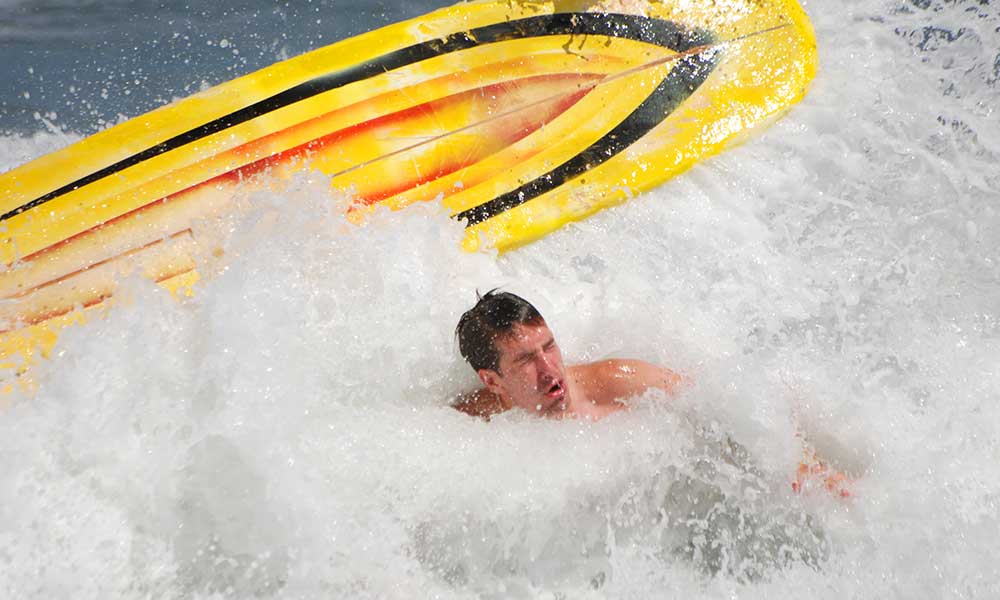Nosediving or “pearling” is when the nose of the surfboard dips into the face of the wave and sends the surfer sprawling into the surf. It’s a common issue among beginner surfers, and in this surfing guide, we’ll show you how to keep those nosedives to a minimum and ultimately how to fix your nosedive once and for all on both shortboards and longboard surfboards.
How Do I Stop My Nose From Diving When Surfing?
Here is some advice and tips for surfers who find themselves nosediving.
Watch the Wave When You Paddle
One reason you may nosedive when you surf is because you are not watching the wave when you paddle.
It’s a common mistake among beginner surfers. They see a wave coming towards them, they turn around and they paddle their arms off in hopes of not missing the wave (again).
Typically, a beginner surfers’ eyes are frequently staring towards the beach or they are heads down with their eyes staring at the deck of the surfboard.
You can prevent nosediving by looking over your shoulder every 2nd or 3rd paddle strokes to see where you are relative to the wave. This should help time your drop in better and avoid nosediving.
Continue to Paddle When You Look Over Your Shoulder
The second reason you may nosedive when surfing is that you stop or pause paddling when you look over your shoulder to check on the approaching wave.
Even a single slight pause in your paddling will change the speed of which you are moving and can put you in a position that will end with a nosedive or a wipeout.
Instead, continue to paddle when you look over your shoulder when you check your position. Keeping a steady flow when paddling will keep you in a better position and should reduce the number of nosedives.
Know The Sweet Spot To Paddle On Your Surfboard
When your body is too far forward on your surfboard when you paddle for a wave, you nosedive. When your body is too far back on your surfboard when you paddle, you end up pushing too much water with your surfboard and you continually miss waves. The solution is to find the sweet spot on your surfboard for paddling.
Here’s an indication to help you know if you are in the sweet spot of your surfboard. Pay attention to the nose of the surfboard. If it is underwater when you are paddling even just a bit you are most likely too far forward and you will probably nosedive when you paddle for a wave.
The natural tendency of many beginner surfers, especially after they nosedive once or twice, is to move too far back on their surfboard and they struggle to catch a wave for the remainder of their surf session. If you have experienced nosediving because you are too far forward, you may just need to move back an inch or two. Many times, moving back just a little will make a big difference.
Don’t Catch Closeouts
Poor wave selection, specifically catching waves that closeout can lead to a nosedive.
The reason for this is that waves that closeout don’t have enough angle to support a good drop in and as a result novice surfers tend to go over the falls and/or wipe out.
Instead, catch waves with plenty of open wave on the shoulder to avoid unnecessary wipeouts.
Don’t Catch Steep Waves
Steep waves can be challenging. If you find yourself nosediving surfing steep waves you may need more practice and/or you may want to surf waves that have more of a roll to them and less of a pitch.
Don’t Hesitate. Commit To The Wave
Hesitating when you paddle won’t help you learn to surf and it can put you in dangerous situations, including nosediving.
It’s better to commit to the wave and paddle like you want it versus paddling half-hearted.
Pop Up On An Angle
Sometimes you need a little bit of an angle to your drop instead of going straight down the wave face which could cause you to dig the nose of your surfboard.
Make Adjustments On The Fly
Sometimes when you paddle, and you see the tip of your surfboard going underwater you can arch your back, lift your head and extend your arms a little. This will put more pressure on your tail and can avoid nosediving.
This can be more difficult on a longboard because there is so much surface area in the nose that once it starts going underwater it can be tough to correct it. Still, arching the back can work on a longboard as well.
Longboard surfers can also try to push the surfboard forward a bit to avoid nosediving if you can anticipate the nosedive.
Take a Surfing Lesson
If you just can’t crack the nosediving code, get a surfing lesson from a professional surfing instructor. Surfing can be so much fun but nosediving can dampen that fun. Contact a local surf shop or instructor to help you stop nosediving.
Summary: How Beginner Surfers Can Stop Nose Diving
That’s it. Get in the water and put the above advice to use to stop nosediving.







